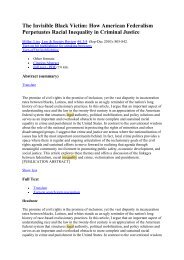Ski – resort and regional development: profile of visitors ... - E-Journal
Ski – resort and regional development: profile of visitors ... - E-Journal
Ski – resort and regional development: profile of visitors ... - E-Journal
You also want an ePaper? Increase the reach of your titles
YUMPU automatically turns print PDFs into web optimized ePapers that Google loves.
154<br />
<strong>Ski</strong> - <strong>resort</strong> <strong>and</strong> <strong>regional</strong> <strong>development</strong>: <strong>pr<strong>of</strong>ile</strong> <strong>of</strong> <strong>visitors</strong> <strong>and</strong> appraisal <strong>of</strong> dem<strong>and</strong> in parnassos ski - <strong>resort</strong><br />
In Northern America, it had been observed an increase regarding cross-country skiing,<br />
backpacking <strong>and</strong> snowboard, from the early 80’s to the middle 90’s (Cordell, 1999). In<br />
Australia <strong>and</strong> Europe, a slowing down in the growth <strong>of</strong> downhill skiing market has been<br />
observed (Buckley et al., 2000; Hudson, 2000). Statistics from the national organization <strong>of</strong><br />
USA ski-<strong>resort</strong>s demonstrate a considerable decline in downhill skiing during the 90’s, while<br />
snow boarding activities almost tripled during that same period.<br />
Pr<strong>of</strong>ound changes were also detected in the mountain tourism patterns <strong>of</strong> Sweden, a country<br />
with a long tradition in mountain sports. In the early 80’s, approximately 22% <strong>of</strong> the Swedish<br />
population would make at least one trip per year to the mountains for downhill skiing (including<br />
snowboarding). In the late 90’s, the percentage had increased significantly to 36%, an increase<br />
corresponding to 970,000 individuals. Snowmobiling, skiing as well as downhill skiing<br />
demonstrated a large increase (from 9% in the 80’s to 16% in the 90’s). Increased number<br />
<strong>of</strong> visits to the northern mountains <strong>of</strong> the country near urban centers might be associated with<br />
short vacation breaks. The observed increase <strong>of</strong> 11% in the average available income between<br />
1981 <strong>and</strong> 1997 coincides with the increase in the cost <strong>of</strong> skiing <strong>and</strong> snowmobiling. Downhill<br />
skiing has demonstrated an increase due to its attractiveness to various age groups that can<br />
participate in the activity at various stages <strong>of</strong> their lives (Fredman <strong>and</strong> Heberlein, 2003).<br />
Local people’s attitude towards tourism <strong>and</strong> views on tourism effects <strong>of</strong>ten vary considerably,<br />
since tourism <strong>development</strong> can be pr<strong>of</strong>itable to some <strong>and</strong> damaging to some others. The net<br />
effect <strong>of</strong> tourism activities in a region has been studied thoroughly in the international literature.<br />
A research conducted in Aren Sweden, suggested that certain local residents acquired significant<br />
pr<strong>of</strong>its from the expansion <strong>of</strong> a ski-<strong>resort</strong> while some others get damaged. Tourists themselves<br />
also acquired certain pr<strong>of</strong>its from the expansion <strong>of</strong> a ski <strong>resort</strong>; however, their benefits were<br />
not large enough in order to counterbalance the net losses experienced by the local residents.<br />
Therefore, the expansion <strong>of</strong> the ski-<strong>resort</strong> resulted in an overall negative change in prosperity<br />
level <strong>of</strong> the society (Lindberg et al., 2001).<br />
Since the early 90’s, the Canadian ski industry has been facing many problems due to low<br />
pr<strong>of</strong>it generation. While it is rather difficult to predict its future, it is quite obvious that the<br />
world ski industry will continue flourishing. Therefore, the Canadian ski industry will have<br />
to develop new products <strong>and</strong> create new alternatives in order to attract more people to the<br />
sport. The Canadian <strong>Ski</strong> Council, in particular, is currently making a considerable effort to<br />
attract people who have never tried skiing. The most important factors keeping potential skiers<br />
away from the mountains are related to the public image <strong>of</strong> skiing created by the media,<br />
training requirements in order to become able to curry out the activity, time requirements <strong>and</strong><br />
costs. Many non-skiers have never trying skiing, either because they have not been told about<br />
the sport’s benefits or due to their biased perceptions about the nature <strong>of</strong> the sport (Williams<br />
<strong>and</strong> Fidgeon, 2000).<br />
According to annual reports from ski-<strong>resort</strong> organizations in Europe <strong>and</strong> N. America, growth<br />
Tourism Today - Fall 2007 - Full Paper














